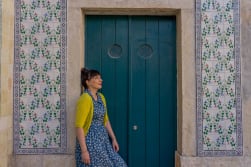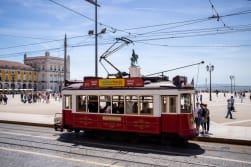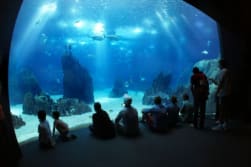What's the most wonderful time of the year? Christmas!
So says the song, and the traditions that are revived every year, all over the world. Portugal is a small country, but it still experiences different traditions from north to south, and here we share with you the best-known ones:
CHRISTMAS AT THE TABLE
Just thinking about "Christmas Eve dinner" brings to mind all the delights that make up a Christmas table!
For many families it's a night of gathering, sharing, enjoying the various delicacies, with cod being king on the night of the 24th! Boiled with potatoes, cabbage and drizzled with olive oil and garlic, it's now the most popular dish in our families, and lately it's taken on variations to suit everyone's tastes and preferences. In the north of the country, it is octopus that has taken its place at the table for the longest time, thanks to Galician influences; but similar to cod, on its preparation and side dishes.
The typical dishes on the Christmas table vary somewhat: sometimes only in name, but each table has its own traditions according to its region. Stuffed turkey is served for Christmas lunch, and in the north of the country, Roupa Velha or “old clothes”, as they name it are enjoyed: it’s Christmas eve codfish leftovers all chopped and fried in olive oil, garlic and bay leaves. There are many desserts, but rice pudding or vermicelli pudding are always present at the table. Broas, small cakes baked with honey and spices, Tronco de Natal, the Yule Log cake, and Lampreia de ovos, a conventual sweet filled with egg strings and shaped like a lamprey. A large proportion of Christmas sweets are fried, and the recipes vary depending on the region, as do the names: filhós or coscorões, rabanadas similar to French toasts, azevias, and pumpkin has a special presence at this time of year, whether in jam with Serra cheese, in Sonhos or in one of the various types of filhoses.

THE CHRISTMAS CAKE THAT IS KING
There are many specialties to be found in bakeries at this time of year, and there's something for everyone, always with lots of sugar and cinnamon. You'll find the famous Bolo-Rei or “king cake”: a round festive cake depicting a crown, with brioche-like dough, wrapped in raisins, dried fruit, candied fruit and sprinkled with sugar. Until recently, each cake came with a hidden dried bean and a "prize", which consisted of a small plastic or metal figure; even if the prize was insignificant, those who took the slice with the hidden prize were considered lucky. Anyone who discovered the bean in their slice was considered "unlucky" - they had to pay for the next cake.

CHRISTMAS DECORATIONS
Christmas celebrates the birth of Jesus and it was St. Francis of Assisi who created the first nativity scene so that everyone could contemplate and meditate on the birth of the Child, lying in the manger, flanked by Mary and Joseph, an Angel, a cow and a donkey. The cribs have grown and in cities across the country we can admire real works of art, whether in churches, central squares or even shopping malls. Some are surrounded by bucolic scenery with moss, flocks of sheep, shepherds, bridges and waterways, castles and even miniatures of the monuments that exist in each of the towns where the crib is displayed. Nativity scenes are also made at home, and the tradition of setting up the "Christmas tree" is much more recent. It was introduced in the 19th century by King Ferdinand II, with his German influences. The first Christmas tree was a pine tree, decorated by the King with candles and fruit; later on, glittering ribbons and colored globes appeared. Nowadays, pine trees are mostly artificial, with coloured lights and more personalized decorations that give the festive season a more sophisticated look. Lisbon has already made the list of the largest Christmas trees built, in 2009 in Lisbon's Praça do Comércio. That year it was classified as the largest Christmas tree in Europe.

CHRISTMAS TRADITIONS
Christmas is both a family festival and a religious festival, as it celebrates the birth of Jesus. On Christmas Eve, people would go to Midnight mass, called the “Rooster Mass”, and at the end they would gather outside around a log that burned throughout the Christmas season in the churchyard, and it was a cozy place where people gathered and lived together in a spirit of family and solidarity. The exact origin of the name given to this Mass is unknown, but one of the legends says that a rooster crowed like never before on the night of the Child's birth, which is why this celebration was given the name Missa do Galo (Rooster Mass). It's a favorite time to spend time with the family around the table, chatting and reminiscing about stories.

CHRISTMAS FESTIVALS
Ice rinks, Christmas markets, attractions and treats - these are the fairs and events that the season brings, all over the country. In cities and towns with castles, this is where the festivals are organized, or else in parks or in the heart of cities, such as Funchal's famous Christmas market, considered one of the best in Europe. Handicrafts, regional products, gastronomic specialties of the Christmas season and amusements such as the Ferris wheel delight kids and adults all over the country. It's best to check online to make sure you don't miss anything at a fair or market that could be just around the corner! Conclusion Whatever the traditions, Christmas is still that special time of year when we feel closer, more festive and checking the scale less. If you're spending Christmas in one of the cities where Yellowbus is present, we may well have a Christmas program waiting for you - and tips to share on social media about what is the most wonderful time of the year.









